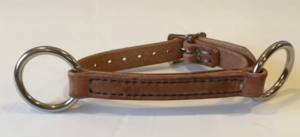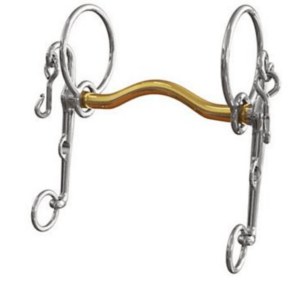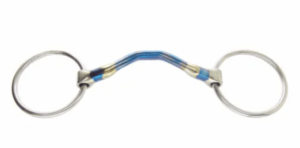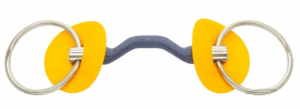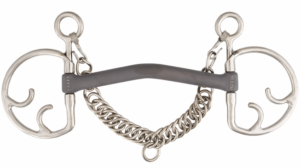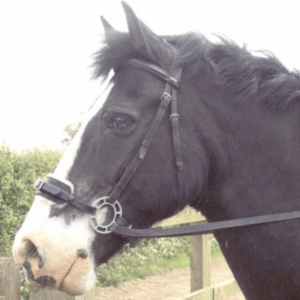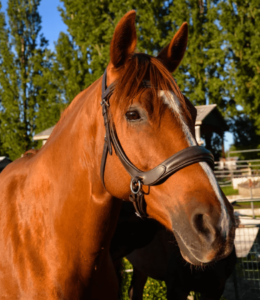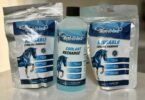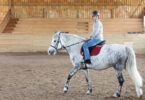A simple bit guide for powerful horses on the rise
Show Jumping is a fast-paced sport that tends to favor forward, bold horses. As such, it is only natural that bit and equipment choices are often at the forefront of riders’ concerns when strategizing how to get around a course successfully.
Unfortunately, due to the nature of the sport, and limited regulations around bits, many people try to use more ‘coercive’ equipment instead of focusing on better training to establish things like rhythm and relaxation.
The result can be a culture that forgets about the horse’s comfort in the show ring.
It is imperative that we view equipment through the lens of how it actually impacts the horse’s body. Many of the most commonly recommended bits for strong show jumping horses may also result in confusion or discomfort to the horse. I strongly encourage riders start by prioritizing flat work and
How to Choose a Jumping Bit
Choosing the right bit requires a lot of thought. We cannot feel the effect of the equipment we put on our horses the way they do. We can only see whether or not said equipment produces the end result we want (e.g. able to slow a horse down).
We need to be careful not to mistake what may feel like a softer and more rideable horse with a horse that’s actually evading contact due to discomfort.
Riders should be educated about the mechanics of the equipment they use and understand how different bits affect the horse. Many problems expose gaps in horse/rider training, anxiety, or fitness.
When we oversimplify “control issues,” assuming they can be easily rectified by changing equipment, we miss the big picture.
With that said, because of the different skill levels of riders, for safety purposes, a smaller or greener rider may need a stronger bit (in the interim) if they are struggling and do not have the skill or physical strength to direct the horse in a softer bit.
Or, alternatively, a rider may need a slightly stronger bit, again for the time being, while their trainer works the same horse in a softer one to help them achieve the necessary softness to become more rideable.
Learn more about the history of different equipment in the All About Bits online course from Krystal Kelly.
Show Jumping Bits for Strong Horses
Pelham
The Pelham is a leverage curb bit that should ideally be used with two reins. This makes it a more complicated bit for inexperienced riders, but two reins allow for the most control in direction so the rider can choose when they need a little bit more “influence” around the course.
In the event that the rider cannot ride with two reins, they must ride with a rein converter that connects to the snaffle ring and curb ring.
This allows the pressure of the bit to be regulated rather than having one rein on the curb, causing the bit to rotate and making the overall leverage action much more harsh than it should be when functioning correctly.
The Pelham should be selected with a mullen mouth / straight bar mouthpiece. Why? Broken mouthpieces have a tendency to wrap the tongue and be much harsher.
What you should know:
- To use this bit most effectively and accurately, learning to ride with two reins is key.
- This bit increases poll and curb pressure along sensitive areas, so is inherently more uncomfortable for the horse—especially if you ride heavy-handedly.
- Be conscious of how strong your horse is and how much you have to use your hands.
- If you’re still having to pull a lot, this is something that should be addressed in flatwork training with a softer bit.
- Make sure the bit is properly fitted, and do not over-tighten the curb chain.
- For horses with sensitive skin, add a rubber or gel cover for the curb chain.
The Pelham is one of the most common bits in the
Bevel Bit
The Bevel bit (sometimes spelled “beval”) is similar an elevator bit, but far less harsh.
I would recommend a Beval bit or the Pelham over an elevator gag any day.
The bevel does not have shanks, so it applies less pressure to the poll. The way it rotates slightly with the bit hooks makes it a stronger bit than a snaffle, due to the presence of poll pressure, but without amplifying that pressure with a shank or curb chain.
What you should know:
- While this bit looks more similar to a snaffle, it does add poll pressure. Be sure you know how to use it properly.
- You should never pair a harsh mouthpiece, like a twisted wire, with a bit like this. The effects becomes much harsher.
- For sensitive horses, these bits can be really nice on soft rubber mullen mouths or leather bits. The added benefit of those mouthpieces is that they are quite flexible and harder for the horse to lean on.
Best Bits for Horses That Lean
Loose Ring Snaffle with Peanut
A loose ring snaffle is a softer bit for a horse that lean thanks to the movement of the rings. It makes it more difficult for the horse to grab the bit because the rings moves and adjusts with the horse.
The best mouthpiece to discourage leaning is a double broken mouthpiece with a smooth peanut or lozenge in the middle.
I prefer these to the french links or Dr. Bristol’s, as they have less of a tendency to dig into the tongue. The double jointed mouthpiece is more collapsible and therefore harder to lean on than a single broken bit or a straight bar.
What you should know:
- This bit is great because it is soft and
dressage legal. - It’s suitable for flatwork schooling, so you don’t have to change equipment between flat rides and jump schools.
- This is a common bit, so it is easy to find in a number of different brands at an affordable price.
- Since this is a snaffle, it is a direct action bit that avoids being overly harsh. Yet, the nature of the design makes it harder for the horse to lean.
- Leaning is something that really should be focused on and fixed in your flat training. This is just a piece of equipment that can help facilitate that learning and discourage heaviness.
Leather Bit
Leather bits are becoming more common on the
Due to their flexible nature, leather bits are harder for horses to lean on.
The leather mouthpiece can be paired with virtually any type of cheekpiece, so it’s very versatile. Use it with a snaffle cheekpiece, or seek out something like a bevel or pelham cheekpiece.
What you should know:
- Leather bits that are completely leather, rather than a leather wrapped metal bit, can be chewed through. So if your horse chews a lot, keep this in mind and always check the integrity of the bit before riding.
- Storing these bits in a dry, warm place is important. They will rot and mold quickly if they’re stored in cool, damp areas.
- These bits are more specialty type bits, and the price tends to reflect this. You may even need to order a custom bit.
- Some leather bits are quite thick for the average horse’s mouth, so keep this in mind and be aware of your horse’s mouth anatomy when choosing a size. Depending on the brand, you may have to size down about ¼ inch.
Swales Pelham
Similar to the regular Pelham, the Swales Pelham is a great bit for sensitive-yet-strong horses. It still applies curb pressure. The rotating bit ring relieves the typical pressure to the poll that comes with similar shanked bits.
This bit helps bring horses heads up and in, and is stronger than a snaffle, but without the added poll pressure.
This bit can be purchased with numerous different types of mouthpieces. I prefer the Trust Innosense (rubber bit for sensitive mouthed horses) with the medium port for tongue relief, Bomber blue (flexible mouthpiece), or the Bomber happy tongue (tongue relief).
What you should know
- This is a good alternative to a regular Pelham for horses who do not tolerate poll pressure.
- This bit is best used with two reins.
- More specialized, so it’s more expensive and may have to be special ordered.
*Not Featured: The Waterford*
If you’ve been in the jumping world for a while, you’re probably wondering why the Waterford didn’t make my list. Even though it’s one of the most commonly suggested bits for strong horses, I don’t recommend it.
The Waterford is often called a “soft bit” because the many different pieces make it almost entirely collapsible. Some claim it contours to the horse’s mouth, but I believe all it really does is create a variety of abrasive pressure points that cause discomfort.
Abrasion worsens when the bit is moving back and forth in the mouth and can rub the horse’s mouth very easily. The pressure points also tend to dig into the tongue and bars of the mouth. This is yet another reason I urge riders to invest in
The idea is to fix underlying rideability issues so you won’t need a harsh bit at all!
Best Bits for Horses That Throw Their Heads
Tongue Relief Snaffle
A lot of horses throw their heads to evade tongue pressure. Something like the Bomber happy tongue snaffle, or the Trust rubber Innosense tongue relief bit, may help.
Tongue relief snaffles are shaped Mullen mouthpieces that allow for more space for the tongue.
Horses who have larger or more sensitive tongues tend to benefit from the extra space, and in turn, become more rideable due to being more comfortable. This is a really nice fix as it doesn’t result in a harsher equipment set up and instead allows for you to work better with your horse by increasing its comfort level.
What you should know:
- Due to being more specialized, these bits do tend to be more expensive, but most of the companies making them allow for customization options and a lot of different cheekpiece options.
- You can choose different snaffle cheekpieces or even get these types of mouthpieces on a pelham or something with a bit more leverage, if your horse is strong.
- Not all horses have tongue sensitivities, so if you can try the bit prior to committing to purchase, you definitely should—to make sure that the tongue sensitivity is a factor in your horse’s way of going.
- Anatomically correct bits allow for problems to be fixed by customizing equipment to the horse’s anatomy and encouraging correct way of going through greater comfort for the horse, thereby making them a more ethical choice.
Bomber Blue Snaffle
This bit is not dissimilar to a leather bit in the sense that it is very flexible in the mouth and therefore takes pressure off of the bars of the mouth. It is an excellent bit for sensitive horses and green horses.
Horses who tend to be head tossers do so due to wanting to avoid the action of the bit, so increasing their comfort should be prioritized when trying to resolve this problem.
This bit is lightweight, more comfortable, and has different options for shaped mouthpieces that are like the aforementioned tongue relief bits as well as straighter, flexible mouthpieces more similar to the soft rubber mullen mouths or leather bits. This bit encourages salivation and acceptance of the bit.
What you should know:
- Since this is a more specialized bit, the price is higher, but the quality is also higher and should last longer than cheaper brands.
- Bomber does custom bit fitting services, so you can custom order with your cheekpiece of choice.
- You also have access to more bit sizes than a lot of other brands provide.
- There are different options for shape for this mouthpiece, giving you a lot of room to customize for your horse and its individual comfort.
- Bomber has consultants that you can contact to try and figure out the best choice for your particular horse.
Baucher Snaffle
The Baucher is known as a hanging cheek and is a cheekpiece that stabilizes the bit more in the mouth than other snaffles. You can get a variety of different mouthpieces with this bit, allowing for customization for what your horse finds most comfortable.
Contrary to popular belief, this bit does not add poll pressure—the bit hangers merely help to stabilize the bit in the mouth.
This makes it a good choice for sensitive, head-tossy horses who need less movement in the mouth. Recommended mouthpieces to try are double jointed with peanut, shaped tongue relief mouthpieces such as the Bomber happy tongue or softer rubber/plastic type mouthpieces like the Bomber blue, Bomber moulded mullen, or the Trust innosense line.
What you should know
- This bit does not add poll pressure.
- This cheekpiece is
dressage legal, making it a good choice if you want a bit that you can use in a variety of show rings. - The Baucher merely refers to the cheekpiece, so you can find this bit with virtually any mouthpiece.
- I would discourage the use of abrasive mouthpieces like twisted wire or slow twists. Stick to simple mouthpieces shaped for the horse’s individual mouth anatomy.
Best Bits for Horses That Rush or Won’t Stop
Kimblehook
The Kimblehook is a leverage bit that utilizes poll and curb pressure to help horses who bolt or rush respond to rein pressure quicker. It offers three different rein placement options that allow the rider to pick the desired amount of leverage for the bit.
The higher the rein placement, the lower the amount of leverage.
What you should know:
- This is a great bit for riders who are not able to use two reins, as it can be used with one rein.
- It is designed to distribute snaffle and curb pressure.
- The Kimblehook is a new take on the traditional Kimblewicke bit.
- This bit is available with a lot of different mouthpieces. The “action” discussed here refers to the cheek pieces and their leverage action.
- I would not recommend any abrasive mouthpiece (i.e. twisted wire). Instead, explore soft mouthpiece options like the Trust Innosense shaped mullens or the many options Bomber bits offers.
Best Bitless Bridles for Jumping
Orbitless Hackamore
A hackamore is the most commonly used bitless option in the jumper ring. The traditional mechanical hackamore features a short shank and curb chain, usually with a sheepskin padded nose piece that attaches to a bridle.
While the mechanical hackamore is most commonly seen, there are varying hackamore options that use different types of nosebands, longer shanks, or even no shanks—like the newer popularized wheel hacks.
The Orbitless hackamore allows riders to purchase an easy-to-use bitless add-on that doesn’t overdo the pressure amount on the face due to lack of shanks.
What you should know:
- This hackamore is a softer option. If your horse is quite strong, you may want a shanked bit.
- Bitless options can still be harsh on the horse, so you must still be mindful of the manner in which you use your hands. Be sure you know how to supple and soften your horse.
- The wheel hacks are not as typically found in stock in tack stores and may need to be ordered online.
- The Orbitless bridle allows for eight different configurations for the reins that change the action of the bitless attachment.
Flower Hackamore
A flower hackamore is a more versatile bitless option that allows the rider to use it with no shank action—or move the rein down onto the short shank to increase the amount of leverage.
For riders who ride multiple horses, or have a horse who may be stronger in certain situations, this can be great as you can adjust the action to be softer or more severe depending on what you need during any given ride.
What you should know:
- Certain shanked hackamore options may need a different type of bridle to stop the cheekpieces of the bridle from sliding into the eye of the horse due to the action and fit of the bit.
- This does not happen with all bridles, but be mindful of the fact that you may need to buy a hackamore bridle for best fit.
- There may be less color and shank length options than with more common mechanical hacks.
Sidepull
The Sidepull is the softest of bitless options and functions most similarly to a halter.
This is not the greatest option for strong horses, as they would have an easier time running through the pressure.
For soft and sensitive horses, though, this is a great choice. Unlike the popular cross-under bitless types, like the Dr. Cook bridles, this one has immediate release and doesn’t tighten under the chin as rein pressure is applied, allowing the rider to add and remove pressure immediately.
What you should know:
- There are tons of different styles and brands of side pulls, so you have lots of options.
- Most side pulls function in the same manner. Just be sure you don’t accidentally purchase a cross-under bitless bridle, as it will function differently and is harsher.
- You do not get as much freedom when it comes to tack appearance as you can with bitless attachments that connect to any type of bridle.
Frequently Asked Questions
How do you know what size bit your horse needs?
The easiest way to ensure you get the correct size is to ask a bit specialist to measure your horse—or to assist you in measuring correctly. Alternatively, you can put a slightly larger bit in your horse’s mouth and mark where the corners of their mouth end on each side to get the overall measurement for the bit.
Finally, there are charts that can give you a rough guess depending on the horse’s bridle size.
What is the easiest bit for a horse?
Any soft snaffle, such as the Trust Innosense bits, or a nice double jointed one with a lozenge is the gentlest option.
Why does my horse chew on the bit?
Chewing can be anxiety or stress related, or related to discomfort or boredom. This behavior needs to be assessed on an individual basis, as the same horse may chew more in certain situations depending on the environment.
Generally speaking, if your horse is chewing and gaping their mouth with a bit every time you ride, there is some level of discomfort and it may be worth looking into what other bitting options may be more comfortable for their anatomy.
Parting Thoughts
It’s important to remember that a bit is only a piece of equipment. Many of the issues we encounter while riding cannot be fixed by a simple equipment change. Try to uncover the root cause of whatever behavioral issue you’re struggling with prior to trying stronger bits.
Training is also needed to help our horses get the muscular strength and suppleness to perform at their best, as well as to further our education as riders.
Equipment is an important part of riding, but the comfort of your horse must remain the top priority. Using stronger bits is not something that should be taken lightly, and riders must understand the action of the equipment they use and how it affects the horse. After all, horses are the ones who can feel any pain or discomfort from the bit. It’s up to each of us to listen.
P.S. Enjoy this article? Trot on over to:
- 5 Best Horse Bits for Control Without Cruelty
- Real Talk: How Much Does a Jumping Horse Cost?
- Bit Basics: Terms All Horse Riders Need to Know
- 5 Best Bits for Horses That Pull Your Arms Off
- 16 Common Types of Horse Bits (A Helpful Illustrated Guide)
- Best Bits for Quarter Horses (A Helpful Illustrated Guide)
- (Bit)Less is More: Bitless Horseback Riding for Beginners
- 5 Best Bits for Your Arabian Horses (English & Western)
- 6 Best Horse Bits for Beginners





